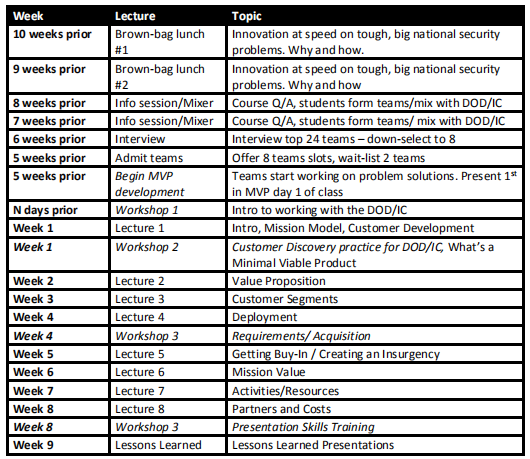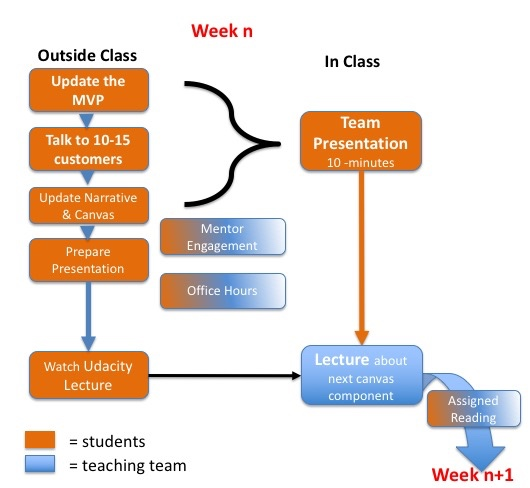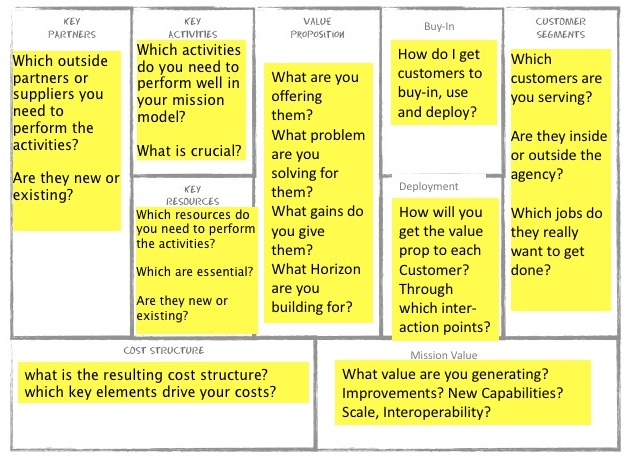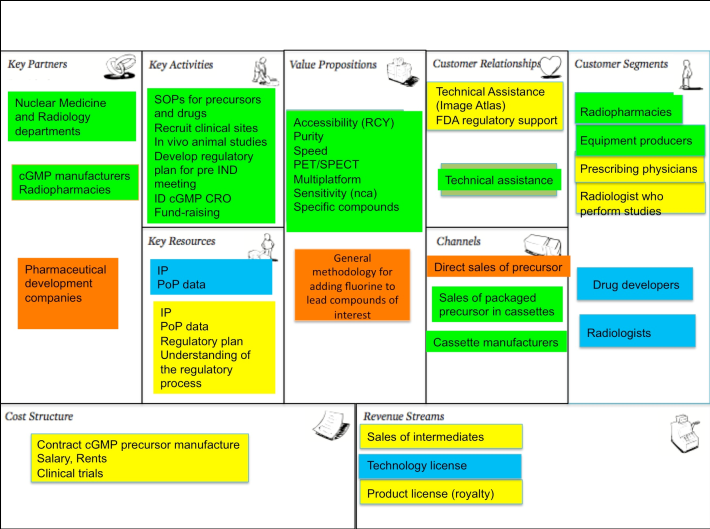快速了解斯坦福大学3个月的训练营H4D的运作模式;通过英文材料+google翻译。
10- and 12-Week Course Logistics
课程长度,10-12周(3个月左右)。
As a result, the class requires a phenomenal amount of work by students, especially compared to most other classes. Teams have reported up to 15 hours of work per student per week. Getting out of the classroom is what the effort is about. If they can’t commit the time to talk to customers, this class is not for them. Teams are expected to have completed at least 10 in-person or Video TeleConference (VTC) interviews each week.
每周需要付出15个小时在课程上,并且每个小组每周需要访谈至少10个利益相关者。这个工作强度非常大,所以每次训练营,学员需要经过选拔,不超过8组,每组不超过4人。
Pre-class Work
As soon teams are admitted, and before class start, teams need to conference with their DOD/IC mentor and:
• Begin to understand the types of customer (users, buyers, requirement writers, etc.)
• Schedule and interview 10 customer before class
• Map out the first hypotheses they want to test and develop and present their first
MVP on day one of the class
课前作业,就需要理解客户的类型(用户、购买者、需求写作者等);计划访谈的10个客户;第一个需要验证的假设与第一天的产品原型。
Assembling the Teaching Team
With no more than 8 teams, a single instructor and a part-time teaching assistant can teach this class. However, the optimal teaching team would have a minimum of:
• Two instructors
• A teaching assistant
• Two mentors per team (one DOD another local)
• Advisors
教学团队构成:2名指导者,1名助教,每个团队2名导师(国防部+本地),顾问团。
The mentors role is to help his/her team test its business model hypotheses and build matching Minimal Viable Products.
指导者的角色在于帮助TA的团队测试商业模式假设,以及构建最小可行产品原型。
(DOD)Provide access to a critical mass of users/stakeholders/partners for interviews (100 when practical)。
导师需要提供100个以上的利益相关者的访谈者联系方式。
Each week’s class is organized around students’ hypothesis-testing their business model assumptions and MVPs outside the classroom.
课程流程:每周班级需要测试商业模式假设与MVP,在教室外实地访谈(或视频访谈)。
配套的课程视频:Udacity如何创业
https://cn.udacity.com/course/how-to-build-a-startup—ep245
Remember that everything you hear from students are hypotheses—guesses—that you want them to turn into facts. “That’s an interesting theory. What experiments can you quickly and inexpensively conduct to prove or disprove this theory?”
学生的一切都是假设——猜测,你需要推动他们找到事实。
很有意思的理论,有什么廉价且快速的试验,能够证明或证伪这个理论(假定)呢?
One of the problems with managing multiple teams is that it is difficult to keep track of
their progress while maintaining a high level of instructor-to-team engagement. Without
some way of keeping detailed track of all teams’ progress during the week, your in-class
critiques would only be based on their 10-minute presentations.
To solve this problem, we insist that each team blog their Customer Discovery progress.
We have them write a narrative each week of customers they’ve visited, hypotheses
they’ve tested, results they’ve found, photos or videos of their meetings, and changes in
their Business Model Canvas. We have them do it all online.
管理多个团队最大的问题就是难以了解各个团队的进展,同时保持一个高水平的导师-团队合作。需要通过一些方式来进行追踪,否则就只剩下每周的10分钟展示了。(真的是通病,特别是一个3个月的训练营;投入了大量的资源)。
为了解决上述问题,每个团队都必须在日志中记录客户发现过程;并且每周记录下客户访谈的发现,测试假设,新的发现等,以及团队会议中的相片或视频,并把上述新的结果在BMC(商业模式画布)上进行更新,所有这一切都在线进行(团队共享、同步信息)。
四本必读书籍
• Business Model Generation: Osterwalder and Pigneur, 2010
• Value Proposition Design: Osterwalder and Pigneur 2014
• The Startup Owner’s Manual: Blank and Dorf, 2012
• Talking to Humans: Constable & Rimalovski
https://book.douban.com/subject/26391979/
https://www.talkingtohumans.com/
• (个人加一本)妈咪测试(the mom test)
https://book.douban.com/subject/26320572/
Each team is expected to speak to 10 or more customers every week. In every cohort, there is almost always one team that, in either week one or week two, has only interviewed 4 or 5 customers. When that happens, we ask them to sit down and won’t let them present.
团队每周都必须至少访谈10个或以上利益相关者(客户);在第一周或第二周,经常会有团队只访谈了4-5人,这时候该团队不能进行展示,以免浪费其他小组的时间。
You want all team members to be familiar with their entire presentation. One way of doing so is to have the TA randomly select which team member presents.
每个人都需要熟悉整个展示文档,我们可以请助教随机选择团队成员之一来进行介绍。(而非每次都是组长或者轮流的组员)
每次10分钟汇报,都有固定的格式,聚焦,减少团队无谓的时间浪费与排版美观。
一共4-5页PPT,10分钟,新的收获教训用不同颜色展示,方便快速比对。
Weekly Lessons Learned Presentation Format
Slide 1 Title slide
• Team name, team members/roles
• Number of customers spoken to this week
• Total number spoken to
• Three sentence description what the team does and why I should care
• Market Size (TAM, SAM, TM, and did it change this week)
Slide 2 MVP
• Show us your MVP of the week
• Tell us what hypothesis the MVP is testing, what data you expected and what you
actually received.
Slide 3: Customer Discovery
• Tell us about your 10 customer interviews.
Hypothesis: Here’s What we Thought
Experiments: Here’s What we Did
Results: Here’s What we Found
Action: Here’s What we Are Going to Do Next
Slide 4: Mission Model Canvas
• Updated Mission Model Canvas with week-to-week changes shown in red
• Multi-sided markets shown in different colors
Slide 5: Diagram (as appropriate)
• Diagram what you learned this week (e.g., customer workflow, payment flows,
distribution channel pictorial)

Figure 2. Lean LaunchPad Application: Mission Model Information

教学方法
本课程使用八种教学方法,这些方法可能对您来说并不新鲜。这些包括:
1.体验式学习
2.基于团队
3.“翻转”教室
4.高级主题讲座
5.每周演讲
6.团队教学
7.观察其他团队并提供建设性反馈
8. LaunchPad Central。
Class Culture
This class pushes many people past their comfort zone. If you believe that the role of your
instructors is to praise in public and criticize in private, do not take this class. You will be
receiving critiques in front of your peers every week.
课程文化
课程将把人推出舒适区。
5天的精益创业训练营
在这个简短的课堂中,学生(四人一组)花半天时间在课堂上通过与客户交谈并生产最低限度可行的产品来测试其假设。团队回到班上并介绍他们发现的内容,然后离开并与更多的客户交谈。重复5天。 所有团队至少与50个客户/合作伙伴/利益相关者进行交谈,有些团队设法达到100个以上。
从现在开始,我对现有市场中的初创企业的第一个问题是:“告诉我现有企业的关键成功因素。”
重点网站
www.launchpadcentral.com
https://steveblank.com/
https://steveblank.com/category/lean-launchpad/
https://venturewell.org/i-corps/team-materials/
https://steveblank.com/slides/
课程详细内容,所有资料!
观察竞争对手的新方法(花瓣图)
https://steveblank.com/2013/11/08/a-new-way-to-look-at-competitors/
创新大师 Steve Blank:“创新者”和“企业家”有什么不同?
创新大师Steve Blank:告诉你什么才是真正的精益创业
卢海:
一个好的教育系统应该让学生至少应该做以下这些事情:
1. 自己调研相关知识;
2. 独立或者跟人合作完成项目;
3. 到相关企业实习,把知识用上;
4. 写论文且公开发表接受批评。

